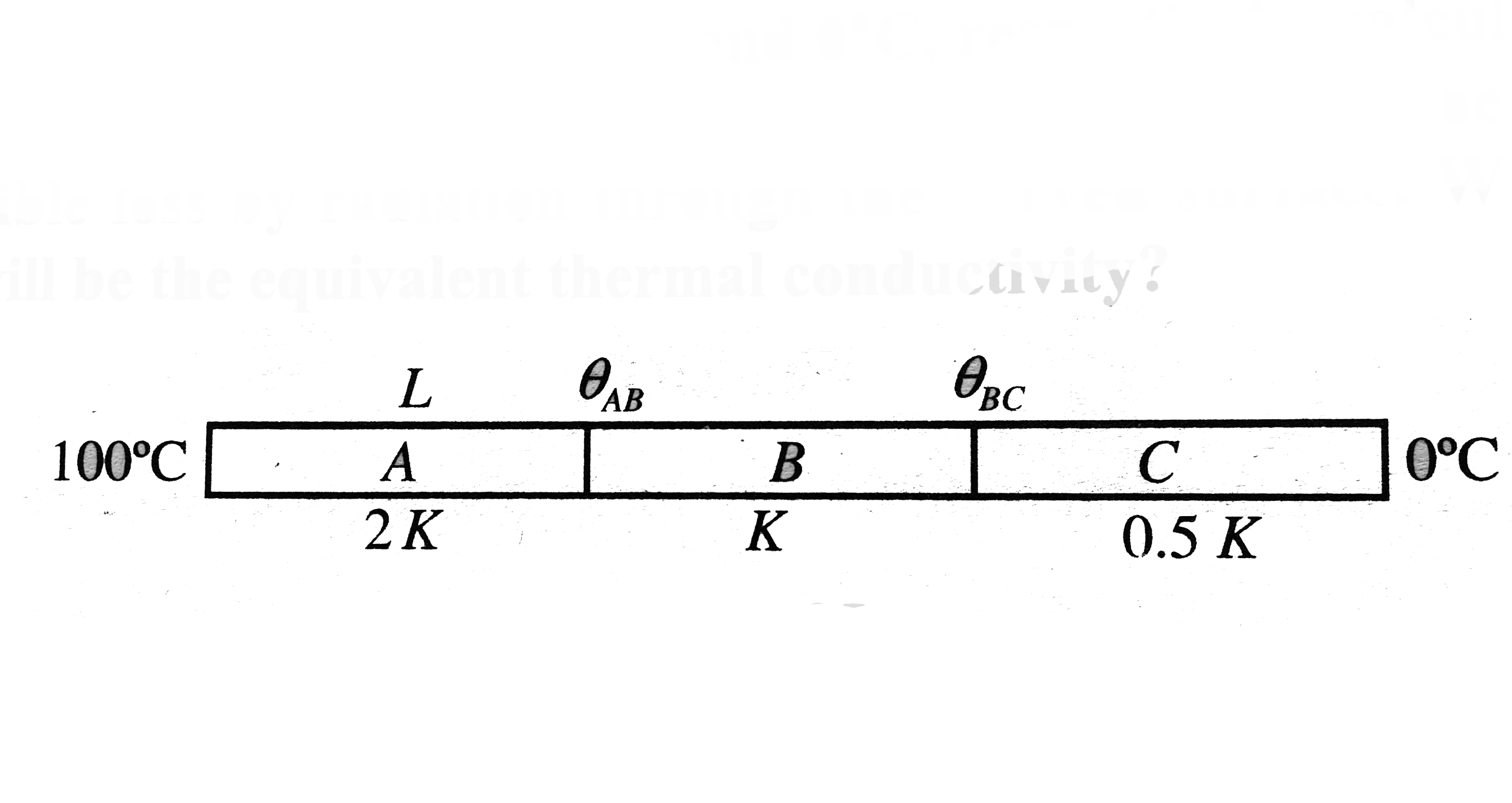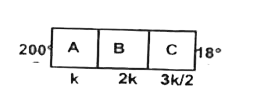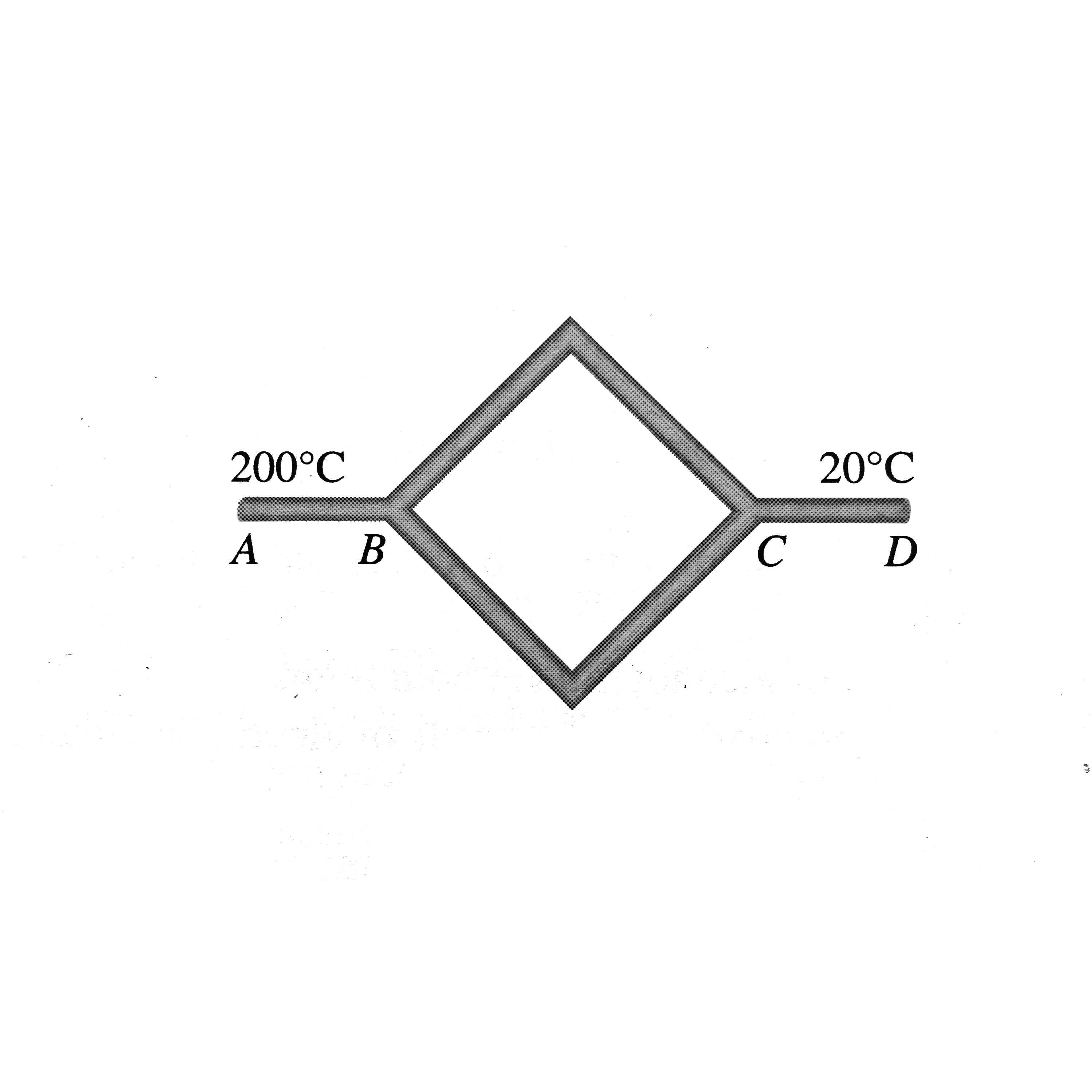In a steady state of thermal conduction, temperature of the ends A and B of a 20 cm long rod are 100∘C and 0∘C respectively. What will be the temperature of the rod at a point at a distance of 9 cm from the end A of the rod
45∘C
55∘C
5∘C
65∘C
The correct Answer is:B
To solve the problem, we need to find the temperature at a point located 9 cm from end A of a 20 cm long rod, where the temperatures at the ends A and B are 100°C and 0°C, respectively.
1. Identify the Lengths and Temperatures:
- Length of the rod (L) = 20 cm
- Temperature at end A (T_A) = 100°C
- Temperature at end B (T_B) = 0°C
- Distance from end A to point C (d) = 9 cm
2. Understand the Concept of Steady State:
- In a steady state of thermal conduction, the heat current (rate of heat transfer) is constant throughout the rod.
- The temperature gradient is linear in a uniform rod, meaning the temperature changes uniformly along the length of the rod.
3. Set Up the Temperature Gradient:
- The temperature difference between the two ends of the rod is:
ΔT=TA−TB=100°C−0°C=100°C
- The total length of the rod is 20 cm, so the temperature gradient (change in temperature per unit length) is:
Temperature Gradient=ΔTL=100°C20 cm=5°C/cm
4. Calculate the Temperature at Point C:
- The distance from end A to point C is 9 cm. Therefore, the temperature drop from end A to point C is:
Temperature Drop=Distance×Temperature Gradient=9 cm×5°C/cm=45°C
- Now, subtract this temperature drop from the temperature at end A to find the temperature at point C:
TC=TA−Temperature Drop=100°C−45°C=55°C
5. Conclusion:
- The temperature at the point located 9 cm from end A is 55°C.
- Length of the rod (L) = 20 cm
- Temperature at end A (T_A) = 100°C
- Temperature at end B (T_B) = 0°C
- Distance from end A to point C (d) = 9 cm
- In a steady state of thermal conduction, the heat current (rate of heat transfer) is constant throughout the rod.
- The temperature gradient is linear in a uniform rod, meaning the temperature changes uniformly along the length of the rod.
- The temperature difference between the two ends of the rod is:
ΔT=TA−TB=100°C−0°C=100°C
- The total length of the rod is 20 cm, so the temperature gradient (change in temperature per unit length) is:
Temperature Gradient=ΔTL=100°C20 cm=5°C/cm
- The distance from end A to point C is 9 cm. Therefore, the temperature drop from end A to point C is:
Temperature Drop=Distance×Temperature Gradient=9 cm×5°C/cm=45°C
- Now, subtract this temperature drop from the temperature at end A to find the temperature at point C:
TC=TA−Temperature Drop=100°C−45°C=55°C
- The temperature at the point located 9 cm from end A is 55°C.
Topper's Solved these Questions
- CALORIMETRY AND HEAT TRANSFERBook:DC PANDEY ENGLISHChapter:CALORIMETRY AND HEAT TRANSFERExercise:Check points 16.4
Explore 29 Videos
- CALORIMETRY AND HEAT TRANSFERBook:DC PANDEY ENGLISHChapter:CALORIMETRY AND HEAT TRANSFERExercise:Taking it together
Explore 51 Videos
- CALORIMETRY AND HEAT TRANSFERBook:DC PANDEY ENGLISHChapter:CALORIMETRY AND HEAT TRANSFERExercise:Check point 16.2
Explore 10 Videos
- CALORIMETRY & HEAT TRANSFERBook:DC PANDEY ENGLISHChapter:CALORIMETRY & HEAT TRANSFERExercise:Level 2 Subjective
Explore 14 Videos
- CENTRE OF MASSBook:DC PANDEY ENGLISHChapter:CENTRE OF MASSExercise:Medical entrances gallery
Explore 27 Videos
Similar Questions
Twelve conducting rods from the sides of a uniform cube of side l. If in steady state, B and H ends of the cube are at 100∘C and 0∘C respectively. Find the temperature of the junction 'A' :-
_E01_117_Q01.png)
View SolutionTwo ends of a conducting rod of varying cross-section are maintained at 200∘C and 0∘C respectively. In steady state:

View Solution
Three cylindrical rods A, B and C of equal lengths and equal diameters are joined in series as shown if Fig. Their thermal conductivities are 2K, K and 0.5K, respectively. In steady state, if the free ends of rods A and C are at 100∘C and 0∘C, respectively, calculate the temperature at the two junction points. Assume negligible loss by radiaiotn through the curved surface. What will be the equivalent thermal conductivity?
View SolutionIn the figure ABC is a conducting rod whose lateral surfaces are insulated. The length of the section AB is one-half of that of BC, and the respective thermal conductivities of the two sections are as given in the figure. If the ends A and C are maintained at 0∘C and 70∘C respectively, the temperature of junction B in the steady state is

View SolutionThree rods A, B and C of the same length and same cross-sectional area are joined as shown. Their thermal conductivities are in the ratio 1:2:3/2. If the open ends of A and C are at 200∘C and 18∘C, respectively, then the temperature at the junction of A at steady state is

View SolutionA rod AB is 1m long. The temperature of its one end A is maintained at 100∘C and other end B at 10∘C, the temperature at a distance of 60 cm from point B is
View SolutionTwo rods of same dimensions, but made of different materials are joined end to end to end with their free end being maintained at 100∘C and 0∘C respectively. The temperature of the junction is 70∘C. Then the temperature of the junction if the rods are inerchanged will be equal to T∘C Find T:
View Solution
Six identical cunducting rods are joined as shown in Fig. Points A and D are maintained at temperatures 200∘C and 20∘C respectively. The temperature of junction B will be
View Solution
Six identical cunducting rods are joined as shown in Fig. Points A and D are maintained at temperatures 200∘C and 20∘C respectively. The temperature of junction B will be
View Solution
Six identical cunducting rods are joined as shown in Fig. Points A and D are maintained at temperatures 200∘C and 20∘C respectively. The temperature of junction B will be
View Solution
